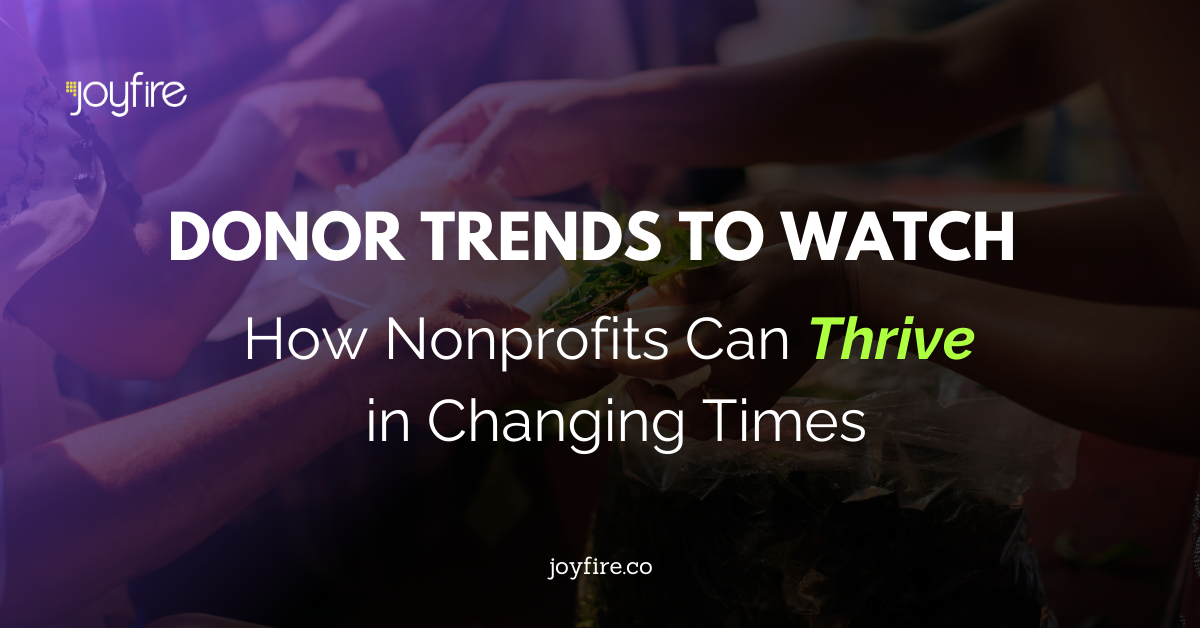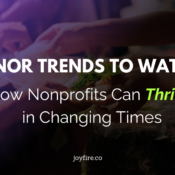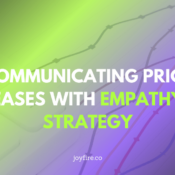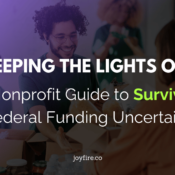
Donor Trends to Watch
How Nonprofits Can Thrive in Changing Times
As impact reports from year-end giving campaigns become widely available across major nonprofits, we can now identify clear patterns in donor behavior. The big news this quarter indicates that donors are increasingly demanding transparent impact measurement and even more convenient digital donation options.
Below, we explore the four most significant trends and provide actionable strategies for nonprofit leaders.
1. Greater Focus on Real-Time Impact
After the 2024 end-of-year fundraising season, many organizations noted that donors wanted near-instant proof of how their gifts were making a difference. During #GivingTuesday2024, there was a 7% rise in “impact reporting”—short videos, social posts, or dashboards showing up-to-the-minute results.
Why It Matters
- Enhanced Decision-Making and Agility — Real-time data empowers nonprofits to quickly pivot strategies if donations drop or beneficiary needs change, rather than waiting for post-campaign analysis.
- Improved Program Effectiveness — Nonprofits can assess programs on the fly, identifying trends or gaps early for faster, more accurate course corrections.
- Better Stakeholder Engagement — Showing donors immediate outcomes can spark a stronger emotional connection and build trust.
- Fundraising Optimization — By monitoring contributions in real time, organizations can personalize follow-ups and adjust messaging.
Your To-Do List
- Share Real-Time Updates — Post short stories on social media or via email showing immediate outcomes.
- Use Quick Visuals — Simple charts or infographics make data clear to donors.
- Explore AI-Driven Analytics — Automated tools can speed up data collection, highlight inefficiencies, and forecast needs.
2. Donors Want An Even More Seamless Digital Experiences
During the 2024 holiday season, mobile-based donations increased by roughly 10%. Donors now expect the ease of shopping online to translate to giving as well. This includes fast load times, intuitive forms, and secure one-click payments.
Why It Matters
- Convenience and Accessibility — Busy top donors want frictionless donation processes. Mobile-responsive websites can dramatically increase donation numbers.
- Higher Conversion Rates — A large percentage of donations come from mobile devices, so any friction can deter potential gifts.
- Enhanced Donor Engagement — Personalized messages, instant donation receipts, and timely updates via text help deepen relationships.
- Increased Retention — Saving payment info and sending easy renewal reminders encourages repeat giving.
Your To-Do List
- Track Donor Behavior — Gather data on how supporters give so you can refine strategies and better engage them over time.
- Optimize Your Donation Page — Keep forms short, simple, and mobile-friendly.
- Provide Multiple Payment Options — Accept credit cards, Apple/Google Pay, and other digital wallets.
3. Growing Interest in Community-Driven Giving
Local giving circles, peer-to-peer fundraisers, and partnerships with area businesses are on the upswing. Donors want to see tangible benefits in their own communities and often prefer grassroots efforts where they can be actively involved.
Why It Matters
- Democratization of Philanthropy — Collective giving models allow donors at all levels to pool resources for a bigger impact.
- Increased Civic Engagement — Community-focused donors often become more involved in advocacy and volunteerism.
- Enhanced Sense of Belonging — Many giving circle participants report feeling a stronger bond with their communities.
- Shift Toward Equity — Community-centric fundraising emphasizes fair practices and fosters diverse participation.
Your To-Do List
- Strengthen Local Ties — Host volunteer days, open houses, and Q&A sessions.
- Collaborate with Local Influencers and Businesses — Co-branded events or matching campaigns can boost reach.
- Adopt Transparent Practices — Let community members help shape program decisions; shared ownership can build lasting loyalty.
4. Shifts in Economic Confidence
Changes in interest rates and the broader economy mean some donors may be more cautious. While high-net-worth donors keep giving, they now want clearer evidence of a nonprofit’s return on impact. More modest donors may hold back or reduce their gifts as inflation or job uncertainties continue to rise.
Why It Matters
- Decreased Donation Value — Inflation can reduce the effective value of contributions, affecting nonprofits’ budgets.
- Diminished Fundraising Potential — Economic uncertainty forces donors to prioritize spending, making strong relationship-building crucial.
- Adaptability Is Key — With thoughtful planning, nonprofits can weather downturns and avoid abrupt financial shortfalls.
- Transparency Builds Trust — Showing how funds are allocated or saved reassures donors you’re stewarding their gifts wisely.
Your To-Do List
- Diversify Revenue Sources — Explore multiple streams (individual gifts, grants, sponsorships) to reduce risk.
- Stay Close to Existing Donors — Keep relationships strong with frequent check-ins and personalized updates.
- Maintain Adaptable Plans — Outline multi-year strategies with back-up scenarios for financial stability.
- Communicate Impact Clearly — Share real outcomes so donors feel their support remains vital—even in challenging times.
Conclusion
Nonprofits that harness real-time data, provide a seamless mobile experience, invest in community-driven philanthropy, and prepare for economic shifts can build resilience and maintain donor engagement—even when uncertainty looms. By being agile, transparent, and community-focused, your organization can thrive and make a lasting difference in an ever-changing world.
Ready to Implement These Strategies? The Joyfire team specializes in helping nonprofits enhance donor engagement and maximize fundraising impact. If you’re looking to implement these approaches or strengthen your donor relationships this year, contact us to discuss how we can support your organization’s growth and mission fulfillment in this evolving landscape.




